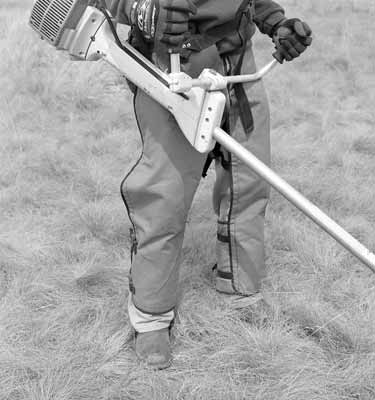 Privacy
| Legal Privacy
| Legal |
Back | Next | Home | Cover Page |
Technology & Development Center |
Brush-Clearing Head Evaluation
The clearing head can throw debris in all directions, including toward the operator. Also, the brush-clearing saw and the noise associated with cutting trees or brush create a noisy working environment. Proper safety and hearing protection equipment are required (figure 5a and figure 5b). The safety equipment and specifications will be listed in the clearing-head operator’s manual. The minimum recommended safety equipment includes:
The equipment above has been field tested to provide maximum operator protection while allowing the operator to be very aggressive with the brush-clearing system. The importance of using this safety equipment cannot be overemphasized.

Figure 5a—Safety equipment (lower body) required to protect
operators using the brush-clearing head.

Figure 5b—Safety equipment (upper body) required to protect
operators using the brush-clearing head.
The clearing-head system was tested by several districts in the Intermountain and Pacific Southwest Regions. The tests were intended to show how well the heads stood up to the rigors of various environments, to obtain workers’ comments on the head’s strengths and weaknesses, and to provide an overall impression of the usefulness of the system. The heads were loaned to the districts for about 2 years so they could use them on a variety of projects. After use, the heads were returned for examination so wear patterns could be examined. Details of the evaluation included:
Results—The brush-clearing head was tested in a variety of conditions and vegetation. These included thinning thick, young ponderosa and lodgepole pine stands (trees 3 to 6 feet tall with 5,000 stems per acre), medium-sized ceanothus, bitterbrush, Douglas-fir, tanoak, manzanita, poison oak, blackberry, madrone, and Oregon grape. Some of the work was for thinning, while other work was for clearing roadsides or firelines.
Blade replacement depended on the site conditions. Some operators working in very rocky conditions suggested that the blades be replaced at least daily, while others working in areas that were not as harsh suggested the blades could last weeks.